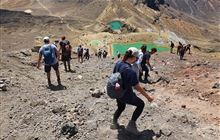Tongariro Alpine Crossing social impact assessment report
Introduction
DOC analysed and reported on the potential social impact of a range of annual visitor numbers (limits) to the Tongariro Alpine Crossing.Download the report
Social impact assessment report: Tongariro Alpine Crossing visitor sustainability (PDF, 1,829K)
Report summary
This report uses information from surveys of visitors and the community, and engagement with stakeholders. It focusses on:
- Insights from a survey of Tongariro Alpine Crossing (TAC) visitors and stakeholder engagement in the recent past.
- Results from a targeted survey of community and stakeholders about the social value of the TAC and various capping scenarios.
The surveys have limitations in terms of sample size and timing, and so the quantitative results should be treated with caution.
This research recognises that every voice represents an important part of the community. It focuses is on the qualitative results, including perceptions of respondents and their rationale for selecting their answers.
Report findings
The report finds that:
- Engagement with visitors and stakeholders shows they support better management of the TAC.
- Visitor satisfaction with the TAC experience is generally high, although perceptions of crowding have an impact on very busy days. Visitor surveys suggest that crowding can be managed with daily limits and /or by limiting arrivals at the start of the track every 30 mins.
- The cultural and environment aspects of the TAC experience are important to visitors.
The social impact survey showed:
- Almost universal agreement that the TAC is fundamental to community identity in the area. And that the TAC is highly valued or valued by the local community. This is due to its cultural significance and its economic benefit to local businesses.
- Environmental and cultural values are recognised. Half of the respondents agree that culture and environment need to be further emphasised as part of improving the visitor experience.
- Opinions vary about potential visitor capping numbers based on different interests, and about the likely effectiveness of some project interventions. But, there is general recognition that measures need to be taken to lift the visitor experience and protect natural and cultural values.

